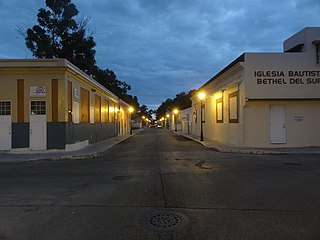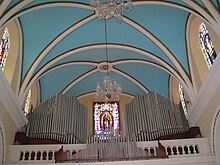
The Catholic Church in Puerto Rico is part of the worldwide Catholic Church in communion with the pope in Rome. The 78 municipalities in Puerto Rico have a Catholic church which is located in the downtown area, normally across from the central plaza.

The Catedral Basílica Metropolitana de San Juan Bautista, or in English, Metropolitan Cathedral Basilica of Saint John the Baptist, is the Catholic cathedral for the Archdiocese of San Juan de Puerto Rico. It is one of the oldest buildings in San Juan, located in Old San Juan, is the oldest cathedral in the United States, and is the second-oldest cathedral in the Americas.

Plaza Las Delicias is the main plaza in the city of Ponce, Puerto Rico. The square is notable for its fountains and for the various monuments it contains. The historic Parque de Bombas and Ponce Cathedral buildings are located within the plaza, which actually consists of two squares: Plaza Muñoz Rivera on the north end, and Plaza Degetau on the southern end. The square is the center of the Ponce Historic Zone, and it is flanked by the historic Ponce City Hall to the south, the early 19th-century Teatro Fox Delicias to the north, the NRHP-listed Banco Crédito y Ahorro Ponceño and Banco de Ponce buildings to the east, and the Armstrong-Poventud Residence to the west. The square dates back to the early Spanish settlement in Ponce of 1670. It is the main tourist attraction of the city, receiving about a quarter of a million visitors per year.

The Metropolitan Cathedral of Saint Elizabeth of Hungary, also known as the National Shrine of Our Lady of the Candles and colloquially as Jaro Cathedral, is a cathedral located in the district of Jaro in Iloilo City, on the island of Panay in the Philippines. The seat of the Roman Catholic Archdiocese of Jaro, it was placed under the patronage of Saint Elizabeth of Hungary. It was established in 1575 as a visita (chapel-of-ease) of Oton by the Augustinians and as a separate parish in 1587. The present-day structure of Jaro Cathedral was built in 1874.

Residencia Armstrong-Poventud is a historic building located in the Ponce Historic Zone in Ponce, Puerto Rico, across from the Catedral Nuestra Señora de Guadalupe. The construction of this home set the stage for the construction of other homes of similar architectural elements, character and opulence in turn-of-the-twentieth-century Ponce. The architectural style is collectively known as Ponce Creole. The home was designed and built by Manuel Víctor Domenech for the Armstrong-Poventud family. It is listed on the U.S. National Register of Historic Places as the Armstrong-Toro House, and is also known as the Casa de las Cariatides. In 1991, the Instituto de Cultura Puertorriqueña turned the house into a museum, which it manages.

The Ponce City Hall is a historic city hall in Ponce, Puerto Rico. It is located it the center of the city, on Calle Degetau, across from Plaza Degetau in the Ponce Historic Zone. The building serves as the seat of the executive branch of government of the Autonomous Municipality of Ponce, including the office of the Mayor of Ponce. Built in 1840, it is the oldest colonial building in the city. The building was listed on the U.S. National Register of Historic Places in 1986 as Casa Alcaldía de Ponce-City Hall.

Plaza Degetau, formally Plaza Federico Degetau, is the larger of two plazas at Plaza Las Delicias, the main city square in the city of Ponce, Puerto Rico. The other plaza is named Plaza Muñoz Rivera and is located north of Plaza Degetau. The square is notable for its fountains and for the various monuments it contains. The historic Parque de Bombas and Ponce Cathedral buildings are located bordering the north side of this plaza. The square is the center of the Ponce Historic Zone, and it is flanked by the historic Ponce City Hall to the south, the cathedral and historic firehouse to the north, the NRHP-listed Banco Crédito y Ahorro Ponceño and Banco de Ponce buildings to the east, and the Armstrong-Poventud Residence to the west. The square dates back to the early Spanish settlement in Ponce of 1670. It is the main tourist attraction of the city, receiving about a quarter of a million visitors per year.

Plaza Muñoz Rivera, formally Plaza Luis Muñoz Rivera, is the smaller of the two plazas at Plaza Las Delicias in the city of Ponce, Puerto Rico. It is located on the north side of Plaza Las Delicias, north of the larger southern Plaza Degetau. The square is notable for its fountains and for the Luis Muñoz Rivera statue. The historic Parque de Bombas and Ponce Cathedral buildings are located immediately to the south of Plaza Muñoz Rivera. The square is at the center of the Ponce Historic Zone, and is flanked by the Armstrong-Poventud Residence to the west, the Teatro Fox Delicias to the north, and Catholic University of Puerto Rico School of Architecture to the east. The square dates back to the early Spanish settlement in Ponce of 1670. It is the main tourist attraction of the city, receiving about a quarter of a million visitors per year.

Segundo is one of the 31 barrios of the municipality of Ponce, Puerto Rico. Along with Primero, Tercero, Cuarto, Quinto, and Sexto, Segundo is one of the municipality's six core urban barrios. It was organized in 1878. Barrio Segundo has 3 subbarrios: Baldority de Castro, Clausells, and Reparada.

The Cathedral of Our Lady of the Assumption, located in the city of Oaxaca de Juarez, Oaxaca, Mexico, is the seat of the Roman Catholic Archdiocese of Antequera, Oaxaca. Its construction began circa 1535 and it was consecrated on 12 July 1733. It is dedicated to Our Lady of the Assumption.

The Ponce Historic Zone is a historic district in downtown Ponce, Puerto Rico, consisting of buildings and structures with architecture that date to the late nineteenth and early twentieth centuries. The zone goes by various names, including Ponce Tradicional, Ponce Centro, Ponce Histórico, and Distrito Histórico.

The Catedral Nuestra Señora de la Candelaria or in English, Our Lady of the Candelaria Cathedral, is the cathedral for the Roman Catholic Diocese of Mayagüez located in the eastern end of the Colón Main Square facing the town hall in Mayagüez, Puerto Rico.
Our Lady of Guadalupe Church may refer to:

The Cathedral of Our Lady of the Holy Assumption, better known as Valladolid Cathedral, is a Roman Catholic church in Valladolid, Spain. The main layout was designed by Juan de Herrera in a Renaissance-style.

The Catedral Santiago Apóstol, or in English, the Cathedral of St. James the Apostle, or Santiago Apóstol of Fajardo is a Catholic cathedral located on the town plaza in Fajardo, Puerto Rico. Along with Concatedral Dulce Nombre de Jesus in Humacao it is the seat of the Diocese of Fajardo-Humacao. It was listed on the National Register of Historic Places as Church Santiago Apóstol of Fajardo in 1984.
The following is a timeline of the history of the city of Ponce, Puerto Rico.
Las Mañanitas is an annual event held in Ponce, Puerto Rico, dedicated to Our Lady of Guadalupe. It consists of a pre-dawn popular parade, followed by a Catholic Mass, and a popular town breakfast hosted by the municipal government. It takes place on 12 December, and is a traditional event sponsored by the Roman Catholic Diocese of Ponce but attended by Catholic leaders from Puerto Rico at large. Widely covered by the press every year, the event is attended by over 10,000 people, including religious and political leaders and the general public. Due to the coronavirus pandemic, the 2020 celebration will take place in a modified program fashion: there will be no walked procession, as traditionally done, but instead the Eucharist will be televised and would-be attendees can instead celebrate Las Mañanitas from their own homes.

Mayagüez barrio-pueblo is a barrio and the administrative center (seat) of Mayagüez, a municipality of Puerto Rico. Its population in 2010 was 26,903.























